Berlin Travel Guide
For many, Berlin is the epitome of all that is great in German culture and this captivating city, a treasure trove of cultural attractions, is also at the heart of the global interest in Germany's turbulent history. Historically, Berlin is one of the most fascinating cities in the world and many people travel here primarily because they are curious about the dark mystique of the capital under Hitler, and the legacy of the Berlin Wall, which featured so prominently in the Cold War imagination. The city has been resurrected as an artistic, vibrant place, and has rapidly regained its pre-war reputation for being a party city. A holiday in Berlin attracts both sophisticated fun-lovers and voracious culture vultures, as there is a great balance between cultural treasures and exciting modern attractions. Visitors can pass through historic sites such as the famous Checkpoint Charlie, take a tour around the iconic Reichstag, or marvel at the splendours of the Charlottenburg Palace, with its impressive collections of art and beautiful gardens.
Berlin's famous cabarets and nightclubs are in full swing, and its opera and concert venues seldom miss a note; the nightlife in this special city will not disappoint. There are also plenty of shopping opportunities in the many great retail streets and malls, and foodies will be similarly delighted by the selection of quality restaurants in Berlin.
Best time to visit Berlin
Berlin is famed for its long, sunny summers (June to late August) and this is the best time to visit, when outdoor cafes in the parks and gardens (especially the Tiergarten) come alive with events. However, Berlin's cultural delights, such as its museums and galleries, make it a year-round destination. Even in winter, often the least popular season to travel in Europe, the Berlin Christmas Markets and New Year's celebrations make it a rewarding time to visit.
What to see in Berlin
-Visit the Allied Museum for an eye-full of interesting war memorabilia.
-Wander along the Berlin Wall's Eastside Gallery admiring the colourful art created in the name of freedom and brotherhood.
-Marvel at the magnificent Berlin Cathedral.
-Enjoy world-class contemporary art the Hamburger Bahnhof Gallery.
What to do in Berlin
-Stroll through the iconic Brandenburg Gate.
-Explore ancient worlds in the breath-taking Pergamon Museum.
-Take the kids to the endlessly popular Berlin Zoo-Aquarium.
-Shop in the exciting atmosphere of the Potsdamer Platz.
Beyond Berlin
Berlin is a great base from which to explore northern and central Germany and, in the unlikely event that visitors exhaust the attractions of the city, they can make use of Berlin's status as an efficient transport hub to travel further afield. The city of Dresden, which suffered terrible destruction during the war, is one of the most popular destinations in Germany and is within easy reach from the capital. Hamburg is also one of the biggest draws to Germany and attracts millions of visitors every year. A little further north is the picturesque town of Lubeck with its remarkable 13th-century architecture.
Getting there
There are flights to Germany from cities all over the world and the most popular airport is Berlin-Tegel Airport, situated a convenient five miles (8km) northwest of the centre of Berlin. Another option is to fly into Berlin Schonefeld Airport, which is situated in the area of the city previously designated as East Berlin, and is 11 miles (18km) southeast of the city centre. Berlin Schonefeld is often cheaper and a good alternative for budget travellers.
Did you know?
-Berlin is the most multi-cultural city in Germany.
-Berlin has about 1,700 bridges, more even than Venice.
-The first set of traffic lights in Europe went up in Potsdamer Platz.
Things to do in Berlin
Berlin is teeming with history and its key attractions bear testimony to that. The sobering Checkpoint Charlie and Jewish Museum serve as stark reminders of Germany's complex past, and history buffs will enjoy exploring all the museums and memorials the German capital has to offer. The remains of the infamous Berlin Wall are now the Eastside Gallery, the largest open-air gallery in the world, displaying graffiti from more than 118 artists from around the world.
Younger travellers should visit the Legoland Discovery Centre, while the historic Hamburger Bahnhof, one of the most popular art galleries, is a must for culture lovers. The Potsdamer Platz is a wonderful place to explore, as it boasts a fantastic mix of restaurants, shopping centres, hotels, a casino, theatres and cinemas. The Kollhoff-Tower located in the square features a panorama platform that offers breathtaking views of the city; it can be reached by Europe's fastest express elevator.
The Berlin Museum Pass, which is valid for three consecutive days, allows free entry to about 40 museums, while the Berlin Welcome Card offers discounts on most of Berlin's major attractions, as well as free travel on public transport within the city. Prices depend on how many days the card is required for. Both cards can be bought online or from railway stations and tourist information centres.
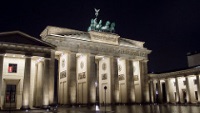
Brandenburg Gate
The impressive and symbolic Brandenburg Gate was built with sandstone in 1791 and consists of 12 massive Doric columns. Topped with a stunning statue of the Goddess of Victory facing east towards the city centre, the gate is closed to traffic, as is the adjacent Pariser Platz, a square at the end of the beautiful Unter den Linden Boulevard. Since the fall of the Berlin Wall, new buildings have been built to designs closely following those destroyed in WWII. It's easy and worthwhile to hire a guide for the area, as the Brandenburg Gate has an intriguing history and a special place in the German culture.
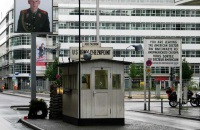
Checkpoint Charlie
The infamous border crossing point in the Berlin Wall dividing West and East Berlin has now become something of a shrine, with the addition of a museum: the Checkpoint Charlie Museum. While the original metal shed is now on display at the Allied Museum, the soldier's post can be visited and tourists can be photographed under the border sign. The museum's permanent exhibition charts the lifespan of the wall, displays objects used to get under, over or through the wall, as well as the stories of those defectors who risked their lives to win their freedom. It hosts lectures and film screenings, and also houses temporary exhibits focusing on general human rights.
Berlin Wall East Side Gallery
The remains of the Berlin Wall have now become the largest open-air art gallery in the world. The longest section is given over to graffiti artists from around the world, demonstrating their skills on the 4,318 foot (1,316m) concrete canvas and turning it into a Berlin landmark. Some of the best known paintings are Dimitri Vrubel's Brotherly Kiss and Gunther Shaefer's Fatherland. The gallery is billed as an international memorial for freedom, the art reflecting the idealism and excitement of the time when the wall was pulled down in 1989.

Berlin Jewish Museum
The Berlin Jewish Museum in Lindenstrasse has gained an international reputation for its significant architecture and unique exhibitions. The bulk of the museum is housed in an intimidating windowless and doorless building situated alongside the yellow Baroque edifice of the Berlin Museum. Visitors enter through the Berlin Museum to explore exhibition rooms clustered around a main axis void, designed to signify the empty and invisible aspects of Jewish history. The museum and its displays are beautifully designed and can be emotionally overwhelming, mixing personal stories, interactive exhibits and mementos with more formal and informative history.
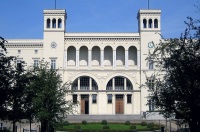
Hamburger Bahnhof
One of the most popular galleries in Berlin, the historic Hamburger Bahnhof in the central Tiergarten district, exhibits an extensive contemporary art collection. Built in 1846 but badly damaged during World War II, this former train station offers 107,639 square feet (10,000 sq metres) of space filled with works by the likes of Andy Warhol, Joseph Beuys and Roy Lichtenstein. The permanent display is the Marx private collection, but there are changing exhibitions and good examples of transavanguardia and minimalism. The gallery holds regular free guided tours for the public, with times displayed on the website.
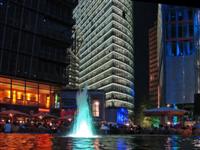
Potsdamer Platz
Potsdamer Platz is the heart and soul of the 'New Berlin', emerging with the fall of the Wall in 1989. The square now contains an exciting mix of restaurants, hotels, a casino, theatres and cinemas, drawing Berliners and tourists seeking culinary delights and memorable recreation. The focus of the square is the 22-storey Debis Haus designed by Renzo Piano, featuring an atrium with cathedral-like dimensions. The Kollhoff building has a panorama platform that offers a gorgeous view of the city, and is reached by Europe's fastest express elevator. The Sony Store is the most recent addition, and consists of eight buildings around a light-flooded arena, which also houses Berlin's popular Film Museum.
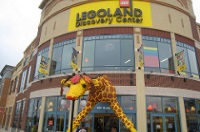
Legoland Discovery Centre
The Legoland Discovery Centre is the first indoor Legoland in the world and provides an interactive journey through a land of creativity, learning and play. Kids will love themed areas ranging from dinosaurs to ninjas. There is a fun factory where Lego bricks are made, a 4D cinema show and even miniature Berlin sights made from Lego. Consistently rated as one of the best family attractions in Berlin, it's also a great place to celebrate birthdays as there are special party rooms for hire and all sorts of exciting perks. The park is designed mainly for kids aged between three and 10.
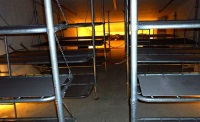
The Story of Berlin
The Story of Berlin is an interactive exhibition recounting the history of the German capital from its foundation until the fall of the Berlin Wall in 1989. It's divided into 25 themed rooms and pays attention to the feelings, thoughts and living conditions of common Berliners, excelling in recreating the atmosphere, mood and aesthetic of different periods. The museum is modern and impressively designed, with a compelling mix of historical analysis and more personal, anecdotal material. One of its main attractions is the nuclear bunker built during the Cold War in the 1970s, and admission price includes an audio tour of it.
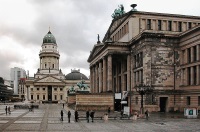
Gendarmenmarkt
Said to be one of the most beautiful squares in Europe, the Gendarmenmarkt in Berlin was created as a marketplace in the 17th century. During World War II most of the buildings surrounding the square were destroyed, but have since been reconstructed and returned to their former glory. The square is dominated by the beautiful concert house, which is home to the Berlin Symphony Orchestra and is a special place to catch a performance. Other notable buildings are the twin churches of Deutscher Dom (German Cathedral) and Franzosischer Dom (French Cathedral). The Gendarmenmarkt stays busy even in winter, playing host to Berlin's best Christmas market and various concerts.
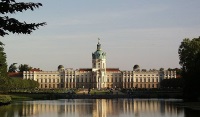
Charlottenburg Palace
Schloss Charlottenburg is the largest and oldest palace in Berlin. The 18th-century Baroque structure was originally constructed as the summer home for Sophie Charlotte, the wife of Elector Frederick III who became the first Prussian king. The splendid interiors are festooned with masterpieces of art, including the largest collection of 18th-century French paintings anywhere outside of France. The surrounding gardens contain a mausoleum, pavilion and the Belvedere, which houses the porcelain museum. For centuries the best artists, architects and landscapers were commissioned to improve and enrich the palace, and the gardens are also lovely.
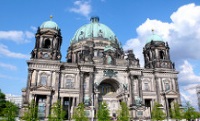
Berliner Dom
The magnificent basilica of the Berlin Cathedral was finished in 1905, and stands on the site of several earlier structures. The largest church in the city, the solemn structure was built in the neo-Rennaisance and neo-Baroque styles, and holds active services, concerts and tours. It is located on the UNESCO heritage-listed Museum Island in Berlin Mitte, which is one of the most renowned museum complexes in the world.
Cathedral visitors love the imposing Sauer organ (made by Wilhelm Carl Friedrich Sauer, a famous organ builder of the Romantic period), the stained-glass windows and the intricate mosaics decorating the dome. The cathedral's crypt contains over 80 sarcophagi of Purssian royals. Tours and audio guides are on offer.
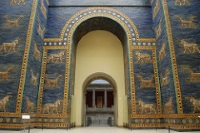
Pergamon Museum
Considered one of the best attractions in Berlin, the huge Pergamon Museum has three main departments: the Antiquity Collection, the Islamic Art Museum and the Middle East Museum. They house parts or replicas of reconstructed monumental buildings transported from excavation sites in foreign lands. The Antiquity Collection contains the Pergamon Altar from the second century BC, as well as the Market Gate of Miletus from Roman antiquity. The main attraction in the Islamic Art Museum is the Mshatta façade originating from a Jordanian desert palace. The Middle East Museum houses the Ishtar Gate and the Procession Way of Babylon, as well as the throne room façade of Nebuchadnezzar II.
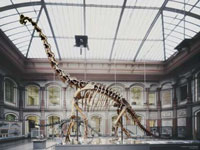
Natural History Museum
Boasting more than 30 million objects throughout its geological, paleontological and zoological collections, the Museum of Natural History in Berlin is the biggest of its kind in Germany and one of the five largest in the world. Visitors will enjoy discovering extensive treasures and learning while they wander the exhibition halls, which take up a massive 71,000 square feet (6,600sq/m). Apart from the ever-popular dinosaur exhibit, highlights include sections on evolution, domestic animals, the cosmos and solar systems, minerals and more. The museum is well organised, with labels in multiple languages and digital audio available in 11 languages.

Berlin Zoo-Aquarium
Children and families love nothing more than trips to the zoo or the aquarium, and Berlin's stunning Zoo-Aquarium combines both with a large focus on conservation and responsible enclosures. The facility is one of the most popular in Europe, entertaining millions of visitors each year with its immense biodiversity from rhinos and pandas to sharks and penguins. Thematic tours such as South America, Asia and Africa are on offer, while there are often special events during the year celebrating Halloween, Easter and Christmas which kids will love. The world's largest inner-city park, Tiergarten adjoins the zoo and a visit is pleasantly combined with a stroll or picnic through these beautiful gardens.

Allied Museum
Occupying an abandoned movie theatre, this museum displays the history of the Allied forces in Germany during World War II and their peacetime presence until 1994. The Allied Museum's collections include all kinds of military memorabilia: airplanes, motor vehicles, weapons, uniforms, documents, photos and other artefacts, including the original Checkpoint Charlie shed. One section focuses on the years 1945 to 1950, covering the end of the war and the Berlin Airlift, while another explores Germany's Cold War experience between 1951 and 1994, featuring large pieces of the Berlin Wall illustrating the history of West Berlin as an island in the Soviet zone. The museum also organises periodic events such as lectures, film screening and special exhibitions.
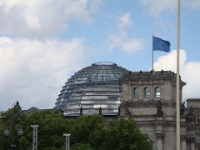
Reichstag
The Reichstag is one of Berlin's most famous buildings and the seat of Germany's parliament since 1894. Enduring a volatile history, its 1999 renovation saw the building gutted, leaving only the facade and the addition of a glass-domed atrium that provides stunning panoramas of Berlin. Tours are on offer but visits are done by contacting the Reichstag beforehand. Although the office is helpful there are thousands of people making this request so advance planning is required to avoid disappointment. Free audio is available in a number of languages.
Things to do with kids in Berlin
Despite its dramatic and sombre history, Berlin is arguably one of the finest cities in Europe for families to explore, offering kids on holiday a multitude of activities and attractions, from the world's largest inner-city park to Legoland and everything in between.
Active families will enjoy heading out to areas such as Großer Müggelsee for a spot of swimming, boating or hiking. Wannsee is perfect for escaping to the outdoors and is a welcome break from traditional sightseeing. Animal and nature lovers will go wild for the Berlin Zoo-Aquarium and the Berlin Botanical Gardens, which offer plenty of space for children to run around and let off steam. The many impressive public squares in the city also provide areas for amusement and lots to keep young minds busy and happy.
When the weather turns bad and outside activities are few and far between, kids can head to one of Berlin's indoor playgrounds or one of the more enticing museums, such as the Museum of Natural History, which could take up most of the day with hundreds of exhibitions.

Legoland Discovery Centre
The Legoland Discovery Centre is the first indoor Legoland in the world and provides an interactive journey through a land of creativity, learning and play. Kids will love themed areas ranging from dinosaurs to ninjas. There is a fun factory where Lego bricks are made, a 4D cinema show and even miniature Berlin sights made from Lego. Consistently rated as one of the best family attractions in Berlin, it's also a great place to celebrate birthdays as there are special party rooms for hire and all sorts of exciting perks. The park is designed mainly for kids aged between three and 10.

Natural History Museum
Boasting more than 30 million objects throughout its geological, paleontological and zoological collections, the Museum of Natural History in Berlin is the biggest of its kind in Germany and one of the five largest in the world. Visitors will enjoy discovering extensive treasures and learning while they wander the exhibition halls, which take up a massive 71,000 square feet (6,600sq/m). Apart from the ever-popular dinosaur exhibit, highlights include sections on evolution, domestic animals, the cosmos and solar systems, minerals and more. The museum is well organised, with labels in multiple languages and digital audio available in 11 languages.

Berlin Zoo-Aquarium
Children and families love nothing more than trips to the zoo or the aquarium, and Berlin's stunning Zoo-Aquarium combines both with a large focus on conservation and responsible enclosures. The facility is one of the most popular in Europe, entertaining millions of visitors each year with its immense biodiversity from rhinos and pandas to sharks and penguins. Thematic tours such as South America, Asia and Africa are on offer, while there are often special events during the year celebrating Halloween, Easter and Christmas which kids will love. The world's largest inner-city park, Tiergarten adjoins the zoo and a visit is pleasantly combined with a stroll or picnic through these beautiful gardens.
Eating Out
Restaurants in Berlin are melting pots of culture and gastronomic delight. The city's culinary traditions have been immensely influenced over the years by its vibrant immigrant community, with authentic international cuisines growing to cement a firm place on the city's food scene.
The flagship dish of Berlin is the simple yet satisfying boulette, a combination of fried meatball and hamburger often accompanied by Berliner Weiße, a traditional mix of sour beer and juice. The highly popular Doner Kebab from Turkish influence is one the most popular fast food dishes, while German favourites such as beer and pretzels are stocked in abundance.
The central Mitte borough, which also contains many of the prime tourist sights, is the best bet for eating out in Berlin. Brimming with a wide variety of restaurants, Oranienburger Street is a particularly enticing option, featuring a buzzing atmosphere and many of the city's most popular restaurants.
Shopping
The German capital can give even the most seasoned of shopaholics a run for their money, offering plenty of opportunities for shopping sprees with establishments such as high-end fashion stores, humble flea markets and enticing antique emporiums.
Luxury designer boutiques are found lining the streets at the west end of Kurfürstendamm and in Friedrichstraße. All the different shopping precincts have their own distinctive style and the best outlets are often tucked away in back alleys or quiet courtyards.
The main shopping districts are the Kurfürstendamm, Breitscheidplatz and the bargain-friendly Budapester Strasse and Tauentzienstraße. One of the trendiest shopping spots is the Schönhauser Allee, with countless independent shops boasting the latest fashion and young independent designer labels which can be snatched up for a song.
Most major stores are open from about 9.30am to 8pm during the week and between 9am and 4pm on Saturdays. They're also usually closed on Sundays, except for smaller ones in the main train stations.
Nightlife
Berlin follows close on Amsterdam's heels for the title of Europe's most liberal city, offering avant-garde setups, trendy bars, risque underground clubs, artistic local hangouts and world-class performing arts. Berlin's nightlife expanded rapidly after the fall of the Berlin Wall, with locals excited to take advantage of a new type of social freedom. The clubbing scene in Berlin is now one of the most competitive and stimulating in the world.
The Mitte district is one of the trendiest, boasting some of the city's most popular party spots but often flooded with tourists. New clubs regularly spring up in Prenzlauer Berg and Friedrichshain, while Kreuzberg is fast becoming a go-to hangout with locals, and is distinguished by its edgy atmosphere. Schoneburg offers some superb cafes and saunas and is quite big with Berlin's gay community, as is Nollendorfplatz.
There are plenty of neighbourhood pubs serving local brews and old favourites, while cabaret is still a popular pastime in Berlin, with many cabaret clubs dotted around this vibrant city. Live music venues dominate much of the city, showcasing both well-known and amateur acts in just about every type of atmosphere, from intimate eateries to grungy music halls.
Getting Around
The Berlin public transport system is efficient, if expensive, and the combination of buses, trams, ferries, the U-Bahn (underground) and S-Bahn (commuter rail) covers every part of the sprawling city and its surrounds. The U-Bahn and S-Bahn are the best ways of getting around. Buses reach the parts of the city that cannot be reached by train, and East Berlin has a network of modernised pre-war trams. One type of ticket is valid on all forms of transport and fares are divided into three colour-coded tariff zones. Driving in Berlin is easier than in most big cities but still not recommended. Traffic is heavy and parking difficult to find and expensive. Taxis and ride-sharing apps are both plentiful, while cycling is a fun and cheap way to get around. There is an extensive network of bike paths around the city, and bikes can be taken onto most forms of public transport, provided a bike ticket is purchased.
Berlin Climate and Weather
Berlin has a continental climate with cold winters, hot summers and mild autumn and spring seasons. The weather in summer (June to August) is mostly pleasant and sunny, with long days and temperatures averaging 73F (23C), but Berlin's climate is unpredictable and the weather can rapidly change. Winters (December to February) can be cold and damp, with the temperature hovering around freezing. Snow falls between December and March, but Berlin seldom stays covered in snow for long. Rain can fall all year round and it is always a good idea to have an umbrella in Berlin, no matter what the season. The wettest months are June and August, and the driest months on average are October and February. Berlin is a year-round travel destination because so much of the city's appeal lies in its cultural and historical attractions, which are fabulous regardless of the weather. The most popular time to visit Berlin is in the summer months when the sidewalk cafes, parks and gardens can be enjoyed to the utmost and there are numerous fun summer events.
Germany travel info
Electricity
230 volts, 50Hz. European-style two-pin plugs are standard.
Language
German is the official language. English is also widely spoken and understood.
Money
The unit of currency is the Euro (EUR), divided into 100 cents. ATMs and exchange bureaux are widely available. The major credit cards are widely accepted in large shops, hotels and restaurants. The quickest and most convenient way to change money is to obtain cash from one of the ATMs that are ubiquitous features on all German streets. Banks are closed on weekends, but exchange bureaux at airports and main railway stations are open daily.
Tipping
German law stipulates that all prices, menus and bills include both tax and a service charge, so tipping is not necessary in restaurants. Cleaning staff, hairdressers, taxi drivers and other menial services appreciate small tips.
Health
There are no serious health risks for visitors to Germany and no vaccinations are required. The German health service is excellent and there is a reciprocal health agreement with most EU countries, whose citizens are entitled to free medical and dental treatment on presentation of a European Health Insurance Card (EHIC). After Brexit, the Global Health Insurance Card (GHIC) replaced the European Health Insurance Card (EHIC) for UK citizens. The GHIC allows UK citizens access to state healthcare during visits to the EU. The GHIC is not valid in Norway, Iceland, Liechtenstein or Switzerland, nor is it an alternative to travel insurance. Nationals of other countries should take out travel insurance.
Safety
A visit to Germany should be trouble free, but visitors should take normal precautions to avoid mugging, bag-snatching and pick-pocketing, especially at airports, railway stations and markets in the large cities.
Local customs
Visitors are not required to carry their passports with them at all times in Germany, but carrying some form of identification is advised. Smoking in public places such as bars and restaurants is illegal.
Doing business
In Germany, business is conducted in a formal manner, with a conservative and formal dress code being the norm. Punctuality is vital at all meetings and it's considered rude to be late. Germans use titles often, with men referred to as 'Herr' and women as 'Frau', followed by their last names.
Meetings are often purely business and may not occur over lunches, which are generally more social. Shaking hands at the beginning and end of the meeting is common. Business hours are generally 9am to 6pm Monday to Friday, with an hour taken over lunch.
Duty free
Passengers arriving from EU countries can enter Germany without paying duty on 800 cigarettes or 400g cigarillos or 200 cigars or 1kg tobacco; 90 litres of still wine; 110 litres of beer; and 10 litres of alcohol stronger than 20 percent or 20 litres of fortified wine, sparkling wine or other liqueurs up to 22 percent.
Passengers arriving from non-EU countries, over the age of 17, can enter Germany without paying duty on 200 cigarettes or 100 cigarillos or 50 cigars or 250g smoking tobacco; 4 litres of wine and 16 litres of beer and 1 litre of spirits over 22 percent volume; or 2 litres of spirits under 22 percent volume. Other goods to the value of €430 for travellers arriving by air or sea, and €300 for travellers arriving by land.
Communications
The international access code for Germany is +49. Travellers will find it easy to use a local SIM card, Skype, WhatsApp or similar apps. Free WiFi is available in most hotels, cafes and restaurants.
Passport & Visa
The borderless region known as the Schengen Area includes the following countries: Austria, Belgium, Czech Republic, Denmark, Estonia, Finland, France, Germany, Greece, Hungary, Iceland, Italy, Latvia, Lithuania, Luxembourg, Malta, The Netherlands, Norway, Poland, Portugal, Slovakia, Slovenia, Spain, Sweden, and Switzerland. All these countries issue a standard Schengen visa that has a multiple entry option, and which allows the holder to travel freely within the borders of all the aforementioned countries. Additionally, non-EEA members require proof of onward or return tickets, the necessary travel documentation for their next destination, and sufficient funds to support themselves while in Germany. Citizens of Australia, Canada, Israel, Japan, New Zealand, Switzerland, and the USA are exempt from the requirement to hold onward tickets.
It is highly recommended that travellers' passports have at least six months' validity remaining after the intended date of departure from their travel destination. Immigration officials often apply different rules to those stated by travel agents and official sources.
Entry requirements
US citizens must have a passport that is valid for three months after the period of intended stay in Germany. A visa is not required for stays of up to 90 days within a 180 day period.
UK citizens must have a passport that is valid for three months after the period of intended stay in Germany. A visa is not required for stays of up to 90 days within a 180 day period.
Canadian citizens must have a passport that is valid for three months beyond the period of intended stay in Germany. A visa is not required for stays of up to 90 days within a 180 day period.
Australian citizens must have a passport that is valid for three months beyond the period of intended stay in Germany. A visa is not required for stays of up to 90 days within a 180 day period.
South African citizens must have a passport that is valid for three months beyond the intended period of stay, and a valid Schengen visa, to enter Germany. Note that Temporary passports will not be recognised.
Irish citizens must have a passport that is valid on arrival in Germany. A visa is not required.
New Zealand citizens must have a passport that is valid for three months beyond the period of intended stay in Germany. A visa is not required for stays of up to 90 days within a 180 day period.
Useful contacts
German National Tourist Board, Frankfurt: +49 (0)69 751 903 or www.germany-tourism.de
110 (Police); 112 (Ambulance/Fire)Embassies / consulates in other countries
German Embassy, Washington DC, United States: +1 202 298 4000.
German Embassy, London, United Kingdom: +44 20 7824 1300.
German Embassy, Ottawa, Canada: +1 613 232 1101.
German Embassy, Canberra, Australia: +61 (0)2 6270 1911.
German Embassy, Pretoria, South Africa: +27 (0)12 427 8900.
German Embassy, Dublin, Ireland: +353 (0)1 269 3011.
German Embassy, Wellington, New Zealand: +64 (0)4 473 6063.
Embassies / consulates in Germany
United States Embassy, Berlin: +49 (0)30 83050.
British Embassy, Berlin: +49 (0)30 20 4570.
Canadian Embassy, Berlin: +49 (0)30 203 120.
Australian Embassy, Berlin: +49 (0)30 880 0880.
South African Embassy, Berlin: +49 (0)30 220 730.
Irish Embassy, Berlin: +49 (0)30 220 720.
New Zealand Embassy, Berlin: +49 (0)30 206 210.



